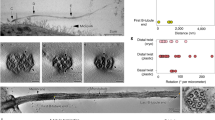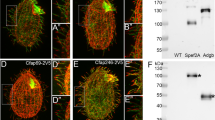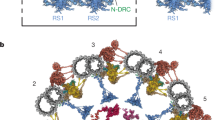Abstract
The centriolar region is a complex structural entity comprising not only centrioles, but also an abundance of associated electron-dense material identified at present only at the ultrastructural level1,2. It is known to contain initiation sites necessary for the assembly of both cytoplasmic and spindle microtubules. Basal bodies, which are structurally related to centrioles, contain the template and serve as initiation sites for the assembly of other microtubule-containing structures, such as the axonemes of cilia and flagella. Immunoglobulins in the sera of some apparently normal rabbits have the ability to bind specifically to centrioles and basal bodies, and have allowed the distribution of these structures to be localized at the light microscope level by immunofluorescence3–5. The identity of the molecule(s) detected by these sera in the centriolar region is unknown, although it is not tubulin, the major identified protein of centrioles4. We describe here the identification of a protein recognized by the immunoglobulins in some normal rabbit sera, of approximate molecular weight (MW) 50,000 in both basal bodies isolated from Tetrahymena pyriformis and in extracts of chicken tracheal epithelial cells.
This is a preview of subscription content, access via your institution
Access options
Subscribe to this journal
Receive 51 print issues and online access
$199.00 per year
only $3.90 per issue
Buy this article
- Purchase on Springer Link
- Instant access to full article PDF
Prices may be subject to local taxes which are calculated during checkout
Similar content being viewed by others
References
Roberts, K. & Hyams, J. S. (eds) Microtubules (Academic, New York, 1980).
Peterson, S. P. & Berns, M. W. Int. Rev. Cytol. 64, 81–106 (1980).
Connolly, J. A., Kalnins, V. I., Cleveland, D. W. & Kirschner, M. W. Proc. natn. Acad. Sci. U.S.A. 74, 2437–2440 (1977).
Connolly, J. A. & Kalnins, V. I. J. Cell Biol. 79, 526–532 (1978).
Wang, E., Connolly, J. A., Kalnins, V. I. & Choppin, P. W., Proc. natn. Acad. Sci. U.S.A. 76, 5719–5723 (1979).
Gould, R. R. J. Cell Biol. 65, 65–74 (1975).
Towbin, H., Staehelin, T. & Gordon, J. Proc. natn. Acad. Sci. U.S.A. 76, 4350–4354 (1979).
Lin, W., Fung, B., Shyamala, M. & Kasamatsu, H. Proc. natn. Acad. Sci. U.S.A. 78, 2373–2377 (1981).
Anderson, R. G. W. & Floyd, A. K. Biochemistry 19, 5625–5631 (1980).
Bird, C. & Zimmerman, A. Expl Cell Res. 128, 199–204 (1980).
Nozawa, Y. & Thompson, G. A. in Biochemistry and Physiology of Protozoa Vol. 2 (eds Levan Dowsk, M. & Hunter, S. H.) 275–338 (Academic, New York, 1979).
Laemmli, U. K. Nature 227, 680–685 (1970).
Weingarten, M. D., Suter, M. M., Littman, D. R. & Kirschner, M. W. Biochemistry 13, 5529–5537 (1974).
Connolly, J. A., Kalnins, V. I., Cleveland, D. W. & Kirschner, M. W. J. Cell Biol. 76, 781–786 (1978).
Author information
Authors and Affiliations
Rights and permissions
About this article
Cite this article
Turksen, K., Aubin, J. & Kalnins, V. Identification of a centriole-associated protein by antibodies present in normal rabbit sera. Nature 298, 763–765 (1982). https://doi.org/10.1038/298763a0
Received:
Accepted:
Issue Date:
DOI: https://doi.org/10.1038/298763a0
This article is cited by
-
Spectrum of centrosome autoantibodies in childhood varicella and post-varicella acute cerebellar ataxia
BMC Pediatrics (2003)
-
Monoclonal antibodies to surface and cytoskeletal components of the spermatozoid ofPteridium aquilinum
Protoplasma (1988)
-
Immuno-electron-microscopic localization of a centriole-related antigen in ciliated cells
Cell and Tissue Research (1985)
Comments
By submitting a comment you agree to abide by our Terms and Community Guidelines. If you find something abusive or that does not comply with our terms or guidelines please flag it as inappropriate.



